#somerset folklore
Text

Creech Hill (nr. Bruton, Somerset, England). A photo taken using infra-red film by Simon Marsden for his book The Haunted Realm. The hill, the highest point for miles around, is said to be haunted by a ghost/bull-beggar that scares those traveling across it at night by rising from the ground and screaming before chasing them away. It was also once the site of small a Romano-Celtic temple (possibly dedicated to Mars) and a very early Christian cemetery. One of the people interred there was a 6-foot tall woman. Waaaay before that it may have the been the location of a much older religious site, as a circle of pits containing burnt red deer antler was also uncovered during the archaeological dig for the temple site.
#simon marsden#photograpy#infrared photography#history#folklore#ghost#somerset#england#romano-celtic#ancient rome
22 notes
·
View notes
Text
So, why do people care so much about Cornish identity? Cornwall’s just a part of England right? Another county with some distinct foods and a funny accent, and they moan about the tourists- when they should be grateful for the money.
Except it’s not.
Whilst the rest of England was forming with a character influenced by Germanic and Norse cultures, Cornwall was holding itself separate as an independent Celtic kingdom, with strong links with Wales, Ireland and Brittany- as well as trading with the wider Mediterranean. For a long time, this kingdom included parts of Devon, but eventually the Celtic people were forced back past the Tamar, and at some point started referring to the land as Kernow, rather than Dumnonia (probably).
Even after the Norman conquest, in part because Cornwall came under the control of the Duke of Brittany, Cornwall retained elements of its unique culture, and certainly its language. There are existing works of literature written in the Cornish language (also called Kernewek) during the medieval period. Due to the active tin mining industry and the Stannary courts, they even had a separate legal system.
All of this continued until the start of the Tudor period, when Henry VII, desperate for money for his wars with Scotland, suspended the operation of the Cornish Stannaries, and imposed greater taxes. This ultimately led to the Cornish Rebellion of 1497. An army of as many as 15000 rebels marched towards Somerset, and ultimately to London, where the rebels met with Henry VII’s armies. Unfortunately, the Cornish lost the ensuing battle, and the rebel leaders were captured, killed and quartered, with their quarters being displayed in Cornwall and Devon. From 1497 to 1508, Cornwall was punished with monetary penalties, impoverishing the people, and land was given to the king’s (English) allies.
However, this wasn’t the death of Cornish culture or dreams of independence from England. Until 1548, Glasney college was still producing literature in Cornish- when it was destroyed in the dissolution of the monasteries, during the English reformation. The following year, 1549, the Cornish rose again- this time to demand a prayer book in their own language, which was still the first (and often only) language of most people in the region. The rebellion was also about the ordinary people vs the landowners, as shown by their slogan “kill all the gentlemen”.
Unfortunately, this rebellion failed too, and this time, it wasn’t just the leaders who were killed, but up to 5,500 Cornishmen- which would have been a significant proportion of the adult male population at the time. These factors combined are widely thought to have contributed to the decline of the Cornish language- although it was still widely in use centuries later.
Despite the failings of these rebellions, the Cornish retained a distinct language and their own culture, folklore and festivals. Mining, farming and fishing meant that the region itself wasn’t economically impoverished, as it was today. Even towards the end of the 1700s, there were still people who spoke Cornish fluently as a first language (including Dolly Pentreath, who definitely wasn’t the last Cornish speaker).
However, over time, the tin mines became less profitable, and Cornwall’s economy started to suffer. Especially in the latter part of the 19th century, many Cornish began to emigrate, especially to places like Australia, New Zealand (or Aotearoa), Canada and South America. Cornish miners were skilled, and were able to send pay back home, and along with the Welsh, influenced culture and sport in many of these places. Many mining terms also have their roots in Cornish language and dialect.
Throughout the 20th Century, Cornwall went through an economic decline- to the point where, when the UK was an EU member, Cornwall was receiving funding intended for only the most deprived regions in Europe. It was one of very few places in the UK to receive this funding- due to the levels of poverty and lack of infrastructure.
Part of the decline was also linked to the decline of historic fish stocks, such as mackerel. In the 70s and 80s, there was a mackerel boom- and large fishing trawlers came from as far away as Scandinavia (as well as Scotland and the north of England) to fish in Cornish waters. The traditional way of fishing in Cornwall used small boats and line fishing. The local fishermen couldn’t compete, and ultimately stocks were decimated by the trawlers. Many more families had to give up their traditional way of life. One could draw parallels here with worldwide indigenous struggles over fishing rights.
Despite this, Cornish communities retained their traditional folklore and festivals, many of which are still celebrated to this day. And throughout the 20th Century, efforts were made to preserve the Cornish language. Although there may not be any first language Cornish speakers left, it is now believed that community knowledge of the language was never truly lost.
Cornwall has since become a popular tourist destination. This brings its own problems- many people want to stay in self-catering accommodation and, more recently, air bnbs. This, alongside second homes, has gutted many Cornish communities. The gap between house prices and average wages is one of the largest in the country. Land has become extremely expensive, which hurts already struggling farmers. Roads can’t cope with the level of traffic. The one (1) major hospital can’t cope with the population in the summer. All of last winter, most Cornish households faced a “hosepipe ban” due to lack of water- yet in the summer, campsites and hotels can fill their swimming pools and hot tubs for the benefit of tourists.
Does this benefit Cornwall? Only about 13% of Cornwall’s GDP comes from tourism. The jobs associated with tourism are often poorly paid and may only offer employment for part of the year. People who stay in Air BnBs may not spend that much money in the community, and the money they pay for accommodation often goes to landlords who live upcountry and aren’t Cornish. Many major hotels and caravan sites are also owned by companies that aren’t Cornish, taking money out of the local economy.
Match this with a housing crisis where it’s increasingly difficult to rent properties long term, and buying a flat or house in Cornwall is out of reach of someone on the average salary and it’s easy to see why people are having to leave communities where their family lived for generations. This damages the local culture, and means centuries-old traditions can come under threat.
All of this feeds into the current situation; it feels like middle class families from London see Cornwall as their playground, and moan about tractors on the road, or the lack of services when they visit. People talk about theme park Cornwall- a place that’s built for entertainment of outsiders, not functionality for those who live here. More widely, a lot of people around the UK have never heard of the Cornish language, or view it as something that’s “extinct” or not worth preserving.
The Cornish are one of Britain’s indigenous cultures, alongside Welsh, Gaelic, Scots, Manx and others. And it’s a culture that’s increasingly under threat economically and culturally. We’ve been clinging on to our homes for a long time, and even now it still feels like we might be forced from them (indeed some of us are). So yes, Cornish people can seem excessively defensive about our identity and our culture- but there’s good reason for it!
#uk politics#cornwall#cornish#kernow#kernewek#celtic languages#minority languages#minority cultures#Cornish history#cornish langblr
265 notes
·
View notes
Text
Deep dives into folklore: Arthurian legends pt 2

The Arthurian legends have captivated imaginations for centuries, weaving a tapestry of chivalry, romance, and heroic quests. While King Arthur himself remains a figure shrouded in myth and mystery, many of the stories associated with him are said to have their roots in the rugged landscapes of Wales. In the second part of this deep dive, we'll embark on a journey to explore modern-day locations in Wales that are believed to be the basis for some of the most enduring tales of King Arthur and his knights.
Tintagel Castle, Cornwall and Dinas Emrys, Gwynedd
Our exploration begins with Tintagel Castle in Cornwall and Dinas Emrys in Gwynedd, both of which are associated with Arthurian legends. Tintagel Castle, perched dramatically on the Cornish coast, is believed by some to be the birthplace of King Arthur. While this claim remains unverified, the castle's dramatic setting and historical significance make it a must-visit for Arthurian enthusiasts. (or at least those with the patience to walk up and down a lot of stairs, trust me, ive been there)
In contrast, Dinas Emrys, a hill fort in Snowdonia, is connected to Arthurian lore through the legend of the red and white dragons. According to the legend, the future King Vortigern sought to build a fortress at Dinas Emrys, but his efforts were thwarted by the discovery of two battling dragons—one white and one red. A young Merlin, believed to have been a wizard and advisor to King Arthur, interpreted this as a prophecy of the conflict between the Britons (represented by the red dragon) and the Saxons (represented by the white dragon).
Caerleon, Newport
Caerleon, a picturesque town near Newport, is often identified with the ancient city of Camelot. In Arthurian legends, Camelot was the legendary court of King Arthur and the Knights of the Round Table. While there is no concrete historical evidence linking Caerleon to Camelot, the town's Roman ruins, including an impressive amphitheater and fortress, add to its mystique. Visitors can explore the remains of Isca Augusta and imagine the grandeur of Arthur's court.
Arthur's Stone, Gower Peninsula
On the stunning Gower Peninsula in South Wales, you'll find Arthur's Stone, a Neolithic burial chamber also known as Maen Ceti. Legend has it that this massive stone was thrown onto the peninsula by King Arthur himself. While this may be a whimsical embellishment, the site's ancient history and striking location overlooking the landscape make it a captivating place to visit.
Llyn Llydaw, Snowdonia
Llyn Llydaw, a serene glacial lake nestled beneath the towering peaks of Snowdonia, is associated with the Lady of the Lake—a character often featured in Arthurian legends. According to the tales, it was here that the Lady of the Lake gave King Arthur the legendary sword Excalibur. While this might be more legend than history, the lake's tranquil beauty and the surrounding wilderness offer a sense of the mystical that resonates with Arthurian themes.
Glastonbury Tor, Somerset
Although not in Wales, Glastonbury Tor in Somerset, England, is closely connected to Arthurian legends and deserves a mention. The Tor is said to be the location of the mythical Avalon, where King Arthur's body was laid to rest after his death. Many believe that the Tor's enigmatic terraces and the nearby Chalice Well Gardens are steeped in the Arthurian legacy, making it a significant pilgrimage site for enthusiasts of the legends.
Conclusion
The modern-day locations in Wales, along with some neighboring areas, offer a rich tapestry of settings and landmarks that have become deeply ingrained in the Arthurian legends. While the historical accuracy of these associations may remain elusive, the charm of these places is undeniable. Whether you're a fervent Arthurian scholar or a casual admirer of legends, exploring these sites provides a tangible connection to the enduring stories of King Arthur and his knights, enriching our understanding of this captivating chapter in Welsh and British folklore.
Taglist (reply or reblog to be added):
@axl-ul @crow-flower @thoughts-fromthevoid @alderwoodbooks @harleyacoincidence @tuberosumtater @sonic-spade @theonlygardenia @holymzogynybatman @nulliel-tres
#writeblr#writers of tumblr#bookish#writing#booklr#fantasy books#creative writing#book blog#ya fantasy books#ya books#deep dives into folklore#merlin bbc#bbc merlin#folklore#books#literature#merlin#king arthur#merlin emrys#arthur pendragon#guinevere#morgana pendragon#gaius
10 notes
·
View notes
Text
Shamanism is on the Rise in the United Kingdom
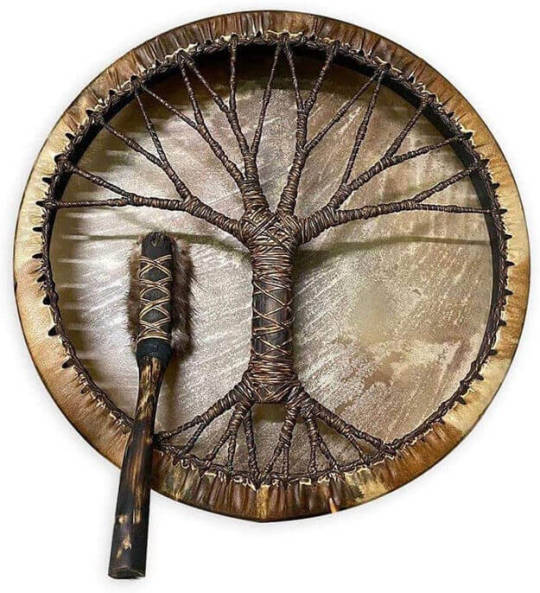
Census data has revealed an unlikely religion is on the rise in England and Wales: shamanism.
Census results published by the Office for National Statistics show that less than half of people in the two British nations, England and Wales, identify themselves as Christian. The announcement has also reportedly renewed calls to end the Church of England's role in parliament and schools.
Notably, Athe people were asked what their religion was rather than about their religious practices or beliefs, a question which is optional since 2001. The number of people who identified as Christians were down from 59.3 per cent in 2011 to 46.6 per cent in 2021. On the other hand, people who said they do not have a religion grew from 25 per cent a decade ago to 37 per cent, last year.
Shamanism is expanding faster than any other religion, with the number of people saying they practice it rising from 650 in 2011 to 8,000 in 2021 in England and Wales. The result might prove controversial, as the Shamanism UK website asserts "it is not a religion, more an authentic expression of mankind’s spirituality."
Pagans and wiccans are also becoming more established. Pagans, who number 74,000 people (up from 57,000 in 2011) and who gather most in Ceredigion, Cornwall and Somerset, and wiccans, who number 13,000. Wicca is sometimes described as a witchcraft tradition whose roots lie in pre-Christian religious traditions, folklore, folk witchcraft and ritual magic.
There was a small rise in numbers of Buddhists. Despite the growth in mindfulness meditation practice over the last decade, the number of people following Buddhism, from which the practice derives, saw just a modest increase of 0.1 percentage points, from 249,000 to 273,000 people identifying as such in England and Wales. The highest concentration of Buddhists was again found in Rushmoor in Hampshire -- home to the Aldershot Buddhist Community Centre -- where the census counted 4,732, up from 3,092 a decade ago.
22 notes
·
View notes
Text
Beast of Exmoor

Generally, it is a good idea for farmers to keep a keen lookout for possible predators for their livestock. But what should they do if that predator is a huge beast which can supposedly hop over high fences and seemingly slip into nothingness? Meet the terror of the English countryside – the frightening Beast of Exmoor.
The Beast of Exmoor is the name given to an animal purported to roam the countryside of Exmoor, in the south-western English counties of Devon and Somerset. This cryptid is believed to be a type of felid, and as it lives outside in a region beyond its natural range, it has been classified as a ‘phantom cat’ or an ‘alien big cat’. Numerous sightings of the Beast of Exmoor have been reported, though some maintain that this animal belongs to the realm of folklore...
The Beast of Exmoor: Is this Phantom Cat More than Mere Folklore?
12 notes
·
View notes
Text
‘No less believable, because he had heard it from “person’s of honour”, was the tradition that Protector Somerset had observed “a bloody sword come out of the wall”, prophesying his own decapitation’.
- D.R Woolf, ‘The “Common Voice”: History, Folklore and Oral Tradition in Early Modern England’, p. 49.
(They should’ve put this in Becoming Elizabeth. For the drama of it all)
#Altho im not sure where it’d fit really lol#Edward Seymour#popular cultures#primary sources#secondary sources#the Tudors#Tudor history#early modern history#Edwardian#becoming Elizabeth#Tudors
5 notes
·
View notes
Photo

The Apple Tree Men [English folktales]
England has a lot apple tree orchards, and many of them are quite old. So it is no surprise that medieval English folklore attributes a supernatural spirit to these places: specifically, the Apple Tree Man. It is said that this aptly named creature takes residence in the first apple tree that is planted in an orchard, and every Apple Tree Man is responsible for improving the fertility of his orchard.
In one folklore tale from Somerset, a poor farmer offers his very last mug of cider to his apple orchard, knowing that he will soon be out of business anyway. The Apple Tree Man in his orchard was moved and grateful, and revealed himself to the farmer. The spirit showed him the location of a buried cache of gold, and when the farmer dug it up he found that this was more than enough to pay all of his debts and rent.
Herefordshire has a tradition where farmers pour cider into the roots of their apple trees. This was intended as an offering to the Apple Tree Man.
Source:
eatsleepliveherefordshire.co.uk/the-apple-tree-man
Which is not a very reliable source, I’m still looking for a decent book on old English folktales. If anyone has some suggestions, I’d appreciate it! I usually check sources like William Henderson, whose 19th century work on British folklore is generally held in high regard. Those books never mention the ‘Apple Tree Men’, making me wonder how old that story really is.
138 notes
·
View notes
Text
*Kicks door down* Okay so the reason Arthur needs... has to have a property out Glastonbury way is because it's just absolutely dripping with old folklore in a manner that the Home Counties like Essex or Kent around London just plain aren't. Those are Saxon and Anglo and Norman. He needs to reject Norman every once in a while. He goes North for Cumbrian lakes and West for Somerset wassailing and even more West to sit at the bottom of a Cornish tin mine when those moods take him.
Glastonbury is weird and old and filled with things that just don't make sense at first glance, never mind the music festival next door (which I am sure Arthur attends off his face for the entire time). Half of it is a manufactured neo paganism of course but it only springs up here because of these old stories. And I think it makes Arthur all the stronger for it.
And it's Celtic, not Norman, not German, not even Roman... it's like the core part of Arthur from when he was a baby. It's his connection to his mother and his siblings. If he ever feels truly like a black sheep, all he needs do is return here and remember. Like even Bath, as wonderful and beautiful and important as it is - is still Roman.
Okay, just to rattle of odd things about the town and why I think it's kind of important when thinking and conceiving of Arthur as a character. It's a microcosm of his history and culture and what's been done to him.
So.
Glastonbury is built at the foot of a hill. The hill stands out like a sore thumb from the surrounding area as everything else is flat. The church fell during an earthquake in the 1200s (we just... don't have earthquakes strong enough to do that) but we kept the tower. A hollow beacon.
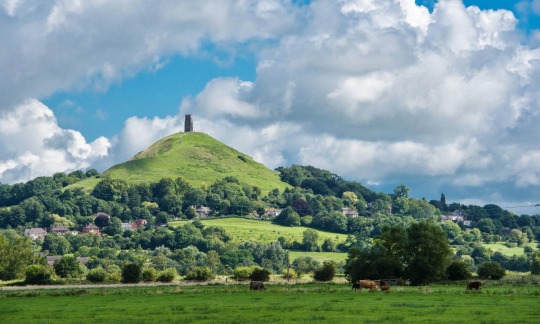

Glastonbury has several iron age lake villages nearby and the Somerset Levels were once upon a time underwater and so all you had was the Tor, poking out as an island amongst the fens, something it does even now in the fog:
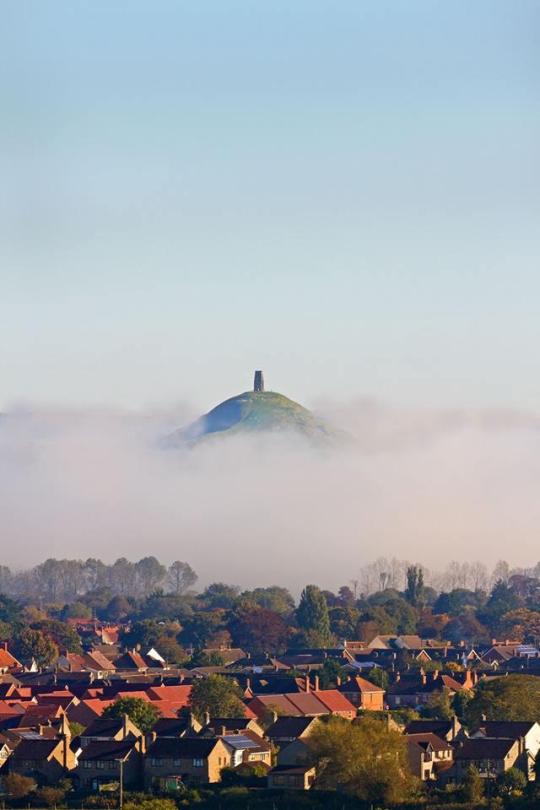
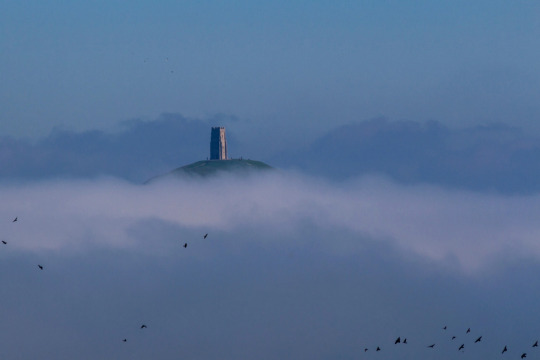
And it was the Normans who drained it and made the island join the mainland but that island is probably possibly potentially where King Arthur is buried. We think. Obviously this is contentious.🤭
So it's maybe. Probably. Most likely. Avalon itself. Isle of Apples. England's national fruit. Glastonbury has the apple festival plus the orchards in the parish and considering it was after all an island once...
Glastonbury Abbey, long before it was a ruin, argued they had his bones. Arthur's. The reformation lost them and the abbot was hung drawn and quartered by Henry VIII. How convenient. Glastonbury Abbey by some counts pre-dates the Roman attempts to enforce Christianity. So it's old as heck. Older than any Anglo-Saxon invader.
It had an English Hawthorn (aka - I shit you not - a Mayflower [cough cough Alfred cough]) tree that bloomed twice a year in the dead of winter and no-one could understand why (stories about the holy grail feature and pop up in other places in Glastonbury). Parliamentarians burned it during the Civil War (Godless and pagan as it was and as spiteful and superstitious as they were) but they used to take cuttings from the tree to send to the Royal Family each Christmas because of its winter flowers. Other cuttings were made and descendants of the tree survive in other places. There's a butt ton of folklore for Hawthorns which I don't have time for but essentially they're fairy houses and borders and don't bring the flowers into your house or you will die. It smells of rotting animals but tastes of bread and cheese. It's a fucked up plant essentially. And it had pretty flowers that we wear on May Day celebrations. Dichotomy. That's... that's Arthur.
And then there's the springs. The Chalice Well and the White Spring. One runs red. One runs white (no it runs clear but it does have chalk in it). They pop out literally across the road from each other despite having completely different sources. They've never dried up in 2,000 years.
One is blood (the Holy Grail returns) and one is milk (I think it's supposed to be the goddess Brighid's milk but I may be misremembering - it's someone's breast milk) so the spring's path and pools runs the most fantastic iron red and clear...
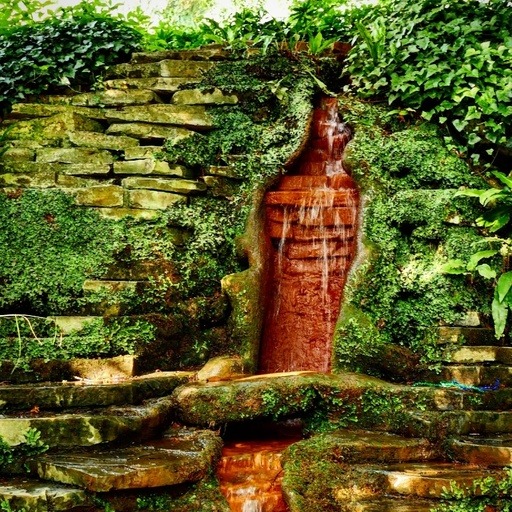

So. Not to be like... insane. But Arthur needs to have a home here. He needs to be able to come back to a place which is his connection with his mother that isn't just the standing stones and tombs of Avebury and Stonehenge and West Kennet. A place which is alive and lived in and used.
A place where the Romans couldn't touch it where the Saxons fought battles to get it where the Normans changed the landscape beyond recognition where Henry VIII sold it and hung drawn and quartered it where the Parliamentarians purged it where his namesake rests. A place where he can drink milk and blood (ooft that's a bit metal eh) and remember. It's a big bundle of changes and trauma and yet it remains all his.
And then he takes too much acid and kind of looses it during the music festival and comes back to five days later with two STIs and desperately needing a bath. #WorthIt

Look at this nonsense. You just know Arthur is passed out in a hedge after listening to something like Marina Diamandis' Savages on stage and having an panic attack of how close it hits home.
#hetalia#hws england#headcanon#op#i.. cannot be... succinct i'm sorry#also Somerset and/or Gloucestershire are just plain pretty it would be nice#having a manor in the cotswolds or the mendlip hills... something like Cothay Manor#one that was built even before the tudors#he can go sit in a cave in cheddar gorge or something#contemplate his life and dissociate or something
24 notes
·
View notes
Photo


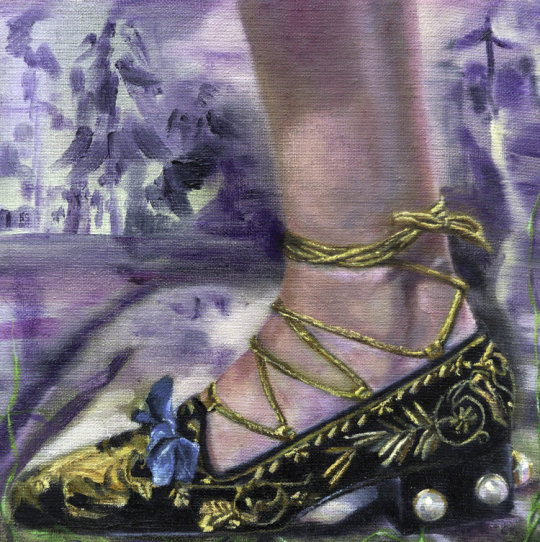

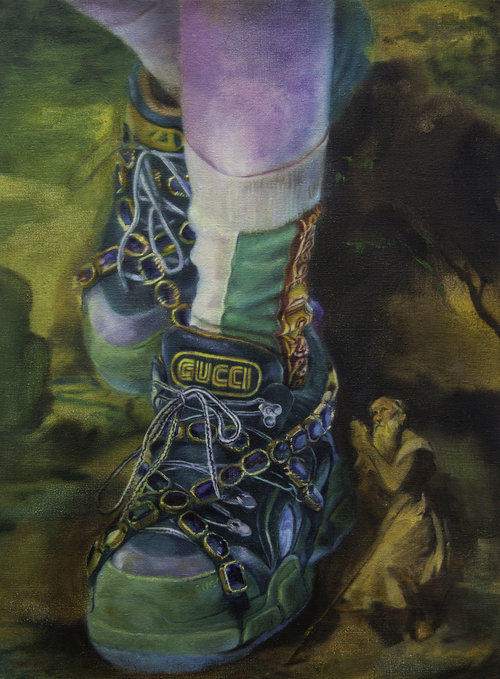

British painter Georgina Clapham - From the series "Shoes".
Painter Georgina Clapham, born Somerset, England, 1993 engages with story telling and theatricality, drawing together Renaissance portraiture, Greek Mythology, folklore, mysticism, animals, nature, the artificial, high fashion, subculture, gender, identity and sexuality, in her meticulous life size figurative paintings.
https://www.georginaclapham.com/
8 notes
·
View notes
Text
Old Dutch Parsonage
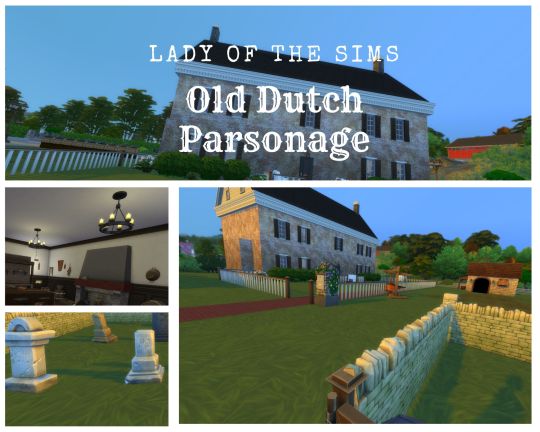
Now available on the Gallery "Old Dutch Parsonage" by "Ladyofthesims". This is my first time loading a lot to the Gallery or here, so any ideas for building or taking better pictures is welcome.
In the real world, the Old Dutch Parsonage is located in Somerset County, New Jersey and is on the U.S. National Register of Historical Places. I discovered the house in a book titled Historic and Memorial Buildings of the Daughters of the American Revolution.
More information about the house and its history can be found here - http://www.wallacehouseassociation.org/
Custom Content List
Simenpaule on Sims Resource (Tavern Ye Medieval Part One and Two) - https://www.thesimsresource.com/members/Simenapule
Angela on Sims Resource (Medieval Market) - https://www.thesimsresource.com/downloads/details/category/sims4-sets-objects-miscellaneous/title/medieval-market/id/1636827/
Lilis-Palace on Tumbler (Folklore Set) - https://lilis-palace.tumblr.com/tagged/ts4%20cc
Historical Sims Life (Book Holder, Rocking Chair, Antique Nursery Child Bed, Toy Chest and Sword Practice Dummy) - http://historicalsimslife.blogspot.com
Felix Andre - (Colonial Set) - https://www.patreon.com/posts/colonial-set-1-28745380
Naunakht - (Firewood Thermostat) Requires seasons - https://www.thesimsresource.com/members/Naunakht/downloads/details/category/sims4-objects-furnishing-electronics-miscellaneous/title/firewood-thermostat-requires-seasons/id/1657161/
Anachrosims on Tumbler (Queens Gallery, Campaign Map's, Horizontal Large, landscape and Seascape paintings, Old manor wall panel and Dark Academy Walls). - https://anachrosims.tumblr.com/
The Jim 07 (Adonis transformed, Narcissus Changed and Hyacinth Changed Paintings) - https://thejim07.tumblr.com
ZxTa (TSM to TS4 Bathtub Military) - https://zx-ta.tumblr.com/post/684709405858627584/tsm-to-ts4-medieval-bathtubs-hello-today-im
TheSenseMedieval (Carts and Sword Practice Dummy) - https://thesensemedieval.tumblr.com/tagged/cc
#sims 4#sims 4 cc#sims 4 gameplay#sims 4 legacy#the sims 4#the sims cc#OldDutchParsonage#new jersey#sims 4 custom content#historical#medieval
3 notes
·
View notes
Text
England and Wales are now minority Christian countries.
1) Shamanism is on the rise
Shamanism is expanding faster than any other religion, with the number of people saying they practise it rising from 650 in 2011 to 8,000 in 2021 in England and Wales. The result might prove controversial, as the Shamanism UK website asserts “it is not a religion, more an authentic expression of mankind’s spirituality”.
2) Pagans and wiccans are becoming more established
More established are pagans, who number 74,000 people (up from 57,000 in 2011) and who gather most in Ceredigion, Cornwall and Somerset, and wiccans, who number 13,000. Wicca is sometimes described as a witchcraft tradition whose roots lie in pre-Christian religious traditions, folklore, folk witchcraft and ritual magic.
3) Romanian is the fastest growing language
“Bine ati venit!” Welcome to the fastest growing language in England and Wales: Romanian. 472,000 people now describe the romance language as their main tongue – up from 68,000 in 2011. The centre of the Romanian-speaking population is Harrow in north-west London.
#england and wales#i know there are a lot of pagans in ceredigion — including my sister#and somerset = Glastonbury#diversity#religion
8 notes
·
View notes
Text
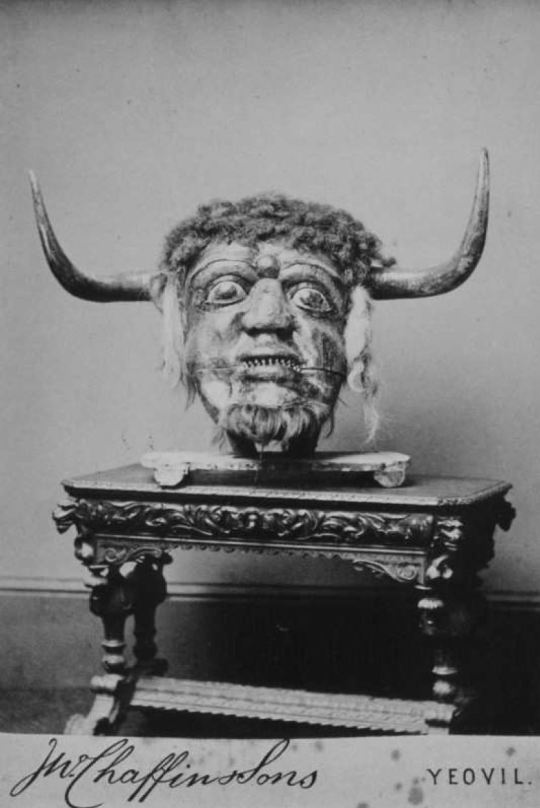

The Dorset Ooser from Melbury Osmond, Dorset, UK. Photographed in Yeovil, Somerset, c. 1883-1891.
A bit of odd photographic history from the town where I was born. Although the scale is difficult to discern from the photo, the Ooser was a largish headress that sat on the wearer's shoulders. The eyes were completely opaque and it's possible that the wearer could see through the 'mouth', which was hinged so that it could open and close. It's actual purpose is unknown, and thus lots of quite silly/colourful (take your pick) ideas have been dreamt up to explain it. The owners tried to sell it, hence the photo, but it seems to have been lost - to decay or being sold by a third party - sometime in the early 1900s. It was made from wood, wool/hair and horn.
#somerset#dorset#yeovil#melbury osmond#UK#england#history#weird history#folklore#local history#headwear#horns#photograpy#vintage photography#ooser#folk horror
4 notes
·
View notes
Text
“Whether the pain of childbirth was natural or spiritual in origin, a consequence of female physiology or the ancestral curse of Eve, women took measures to lessen its intensity and reduce its accompanying peril. Midwives, wise women, and many of the sorority of matrons who gathered in the birthroom knew special phrases as well as concoctions and applications of sympathetic magic that would help a woman through pregnancy and labor. The female subculture of childbirth included intimate practices and beliefs that were barely suspected by husbands or priests, were long resistant to reform, and remain virtually inaccessible to historians.
Late medieval midwives are said to have used the following Latin charm: “O fans, sive vivus, sive mortuus,exi foras, quia Christus te vocat ad lucem” (O infant, whether dead or alive, come forth, because Christ calls out you to the light), which sounds more learned than popular. A Leicestershire midwife was reportedly heard intoning, “In the name of the Father and of the Son and of the Holy Ghost, come safe and go safe, what have we here,” during the course of a difficult delivery in 1569. Others may have used less recognizably Christian prayers. Herbal medicine, primarily in the female domain, offered a variety of remedies for hastening or easing delivery. “Kitchen physic” yielded salves and candles that could be administered with or without accompanying prayers. A diligent midwife’s physic garden would include lilies and roses, cyclamen or sowbread, columbine or aquilegia, all of which were believed to ease the pains of birth or to hasten delivery.
Traditional herbals included remedies “to help conception,” “to nourish the child in the womb,” “to stay the longing of woman with child,” “to procure an easy and speedy delivery to women in travail,” “to bring down the afterbirth,” and “to increase milk in women’s breasts.” Printed herbals, which were frequently refined and republished in the sixteenth and seventeenth centuries, served as botanical histories and pharmacological reference works for apothecaries and physicians, but they also gave scholarly botanical precision to the folkloric general knowledge of wise women and midwives. In addition to traditional herbal concoctions for women in labor, laudanum became available in late Elizabethan London, to be joined in the seventeenth century by such questionable remedies as the exotic Maldiva nut.
Traditional Roman Catholicism offered an armory of comforts to the childbearing woman, many of which were discredited with the Reformation. Under the old dispensation, a woman in labor could call on Saint Margaret or the Virgin or one of a host of local supernatural helpers, and she could supplement this saintly intercession by clutching religious relics, girdles, amulets, and fragments of the consecrated host. Only through inquiries at the dissolution of the monasteries in 1536 do we learn that the convent of Bruton, Somerset, treasured “our lady’s girdle of Bruton, red silk, which is a solemn relic sent to women travailing which shall not miscarry in partu.” Other monastic houses loaned out holy girdles or belts, necklaces, and relics as aids to women who were pregnant or lying in.
Bishop Nicholas Shaxton of Salisbury thought it necessary in 1538 to prohibit the use of “any girdles, purses, measures of our Lady, or such other superstitious things, to be occupied about the woman while she laboureth, to make her believe to have the better speed by it.” In some places, it was believed, a woman’s own girdle would serve to ease labor if it had been wrapped around sanctified bells. Village wisdom and folk religion provided additional assistance in the form of special stones, charms, and potions that promised a safe deliverance or relief from childbed pains.
In traditional popular Catholicism, the holy sacrament was the most powerful medicine of all. The Sarum Missal, one of the most popular formularies of pre-Reformation worship, included masses “on behalf of women labouring with child” and supplications to Saint Mary, “the benign assister of women in travail.” The Catholic Bishop Bonner admonished childbearing women in mid-Tudor England “to come to confession and to receive the sacrament especially when their time draweth nigh.” Some people believed that attendance at Mass in this condition helped the unborn child as well as the expectant mother, and that its spiritual benefits extended to a child who might die before baptism.
If the woman could not come to Mass, then the Mass, or some part of it, might be taken to the woman. Alice Thornton, a staunchly Protestant Yorkshire woman, took the sacrament in 1665 in readiness for lying in. “After this great mercy in the renewing of our vows and covenants with God,” she declared, “I was fully satisfied in that condition, whether for life or death.” In later seventeenth century variants on this tradition, Margaret Godolphin “received the heavenly Viaticum” (her name for the eucharist) at the onset of labor in 1678, and John Evelyn’s daughter took the sacrament a week after giving birth in September 1694. Like the Mass a century or more earlier, the eucharist served to settle the soul in preparation for an unpredictable outcome.
The Elizabethan Jesuit John Gerard told the story of Lady Grisell Wodehouse, who seemed to be dying after childbirth. “An old priest, one of those ordained before the beginning of Elizabeth’s reign [came] to give the lady all the last rites of the church. After making her confession she was anointed and received Viaticum and (this is the wonderful thing) within half an hour she was recovered and was out of danger.” Gerard marveled that her husband, Sir Philip Wodehouse, a Protestant, “wondered how it had happened. We explained to him that one of the effects of the holy sacrament of Extreme Unction was to restore bodily health when God judged it to be for the soul’s good. This completed the husband’s conversion.”
Protestants would have been shocked by this recommendation of unction and by other signs of resurgent Catholicism. Reforming churchmen sought to suppress traditional practices they deemed superstitious, including women’s semisecret rituals surrounding childbirth. The Protestant attack was most ardent during Elizabeth’s reign, when “superstitious” customs were still deeply entrenched. But unauthorized practices continued in the perilous intimacy of the birthroom long after the establishment of the Reformation, and not only in the much maligned “dark corners of the land.”
Protestant hostility to potions and charms formed part of the larger campaign for the reformation of manners and the expunging of superstition. It was not explicitly misogynist, although it stripped away some female comforts. The Church of England no longer countenanced a woman’s promise to go on pilgrimages if God gave her an easy labor. Bishop Barnes of Durham instructed his clergy in 1577 to discipline “all such woman as shall . . . at the child’s birth use superstitious ceremonies, prisons, charms or devilish rites or sorceries.” Midwives were put on oath not to “use any kind of sorcery or incantation” and to inform against any who so offended.
Many traditional practices survived the Reformation, and not all were corrected by Protestant instruction. Richard Greenham, ministering to his parishioners in Elizabethan Cambridgeshire, observed many things to be corrupted by superstition which were good in their first original, as, when women drawing near the time of their deliverance do require the prayers of the church, as in a farewell commit themselves to the intercessions of the saints, partly for that they are about to enter into a dangerous travail, partly for that they shall be long without the public means of the assembly, and therefore stand in need of the grace of God watching over them.
Though it was perfectly understandable that women should clutch at whatever helped sustain them through the travails of childbirth, it was offensive to advanced Protestant sensibilities if those props were tinged with Catholicism and superstition. Catholic families were especially instrumental in keeping traditional practices alive, including recourse to holy girdles and invocations of the saints. But one did not have to be a follower of the old religion to turn to eagle stones or other childbirth talismans. One such wonder was offered to Margaret Cavendish, the Countess of Newcastle, to ease her labor in 1633. Anne, Viscountess Conway, secured another, which she wore while pregnant in 1658 for its “great virtue in hard labour.”
So-called eagle stones (aetites, a stone within a stone) reputedly came from Cyprus or Africa, but they were readily “to be had in London” and were strongly recommended. The seventeenth-century midwife Jane Sharp advised expectant mothers to wear one, “for I have proved it to be true, that this stone hanged about a woman’s neck and so as to touch her skin, when she is with child, will preserve her safe from abortion, and will cause her to be safe delivered when the time comes.” Other medical manuals repeated this advice. The nested stones apparently worked through the principles of sympathies and signatures, the stone within the stone signifying the security of the child within the womb. Alternatives to the eagle stone included therapeutic lodestones and “the skin of a wild ox” tied to the woman’s thighs.
Rather than deriding such practices as superstitious, the more thoughtful commentators commended the goodwill shown by friends who provided these items and the solicitude of husbands who sought to protect their wives and future offspring by every means their culture afforded English Protestantism continued to provide a powerful range of spiritual comfort and assistance to women in need. Although the Church of England no longer countenanced special masses for childbearing women or prayers to the saints on their behalf during labor, it strenuously encouraged the use of prayer. In the crisis of childbirth, when life and death walked hand in hand, a pious family had but one place to turn.
Domestic prayers and religious exercises were designed to attract God’s attention; they petitioned, they assuaged, they explained; and they provided a pathway to reconciliation if anything went seriously wrong. Thomas Bentley’s massive Monument of Matrons, published in 1582, includes model prayers for “women with child, and in childbed, and after their delivery,” as well as prayers for midwives and prayers of thanksgiving. Devotional exercises for use during pregnancy and labor formed part of the revived religiosity of early Stuart England. They were written by mainstream Calvinists as well as by advanced Arminians. Though framed by reference to Eve’s transgression, their prayers did not dwell on pain and punishment but stressed instead the blessings of fruitfulness, the honor to women, divine deliverance, and the prospect of salvation.
Popular devotional manuals such as Robert Hill’s Pathway to Prayer and Pietie, which went through eight editions between 1606 and 1628, included model prayers and meditations for women in travail. So too did Samuel Hieron’s A Helpe Unto Devotion, which reached its twentieth edition in 1636. Daniel Featley’s Ancilla Pietatis: or, The Hand-Maid to Private Devotion, which went through six editions between 1626 and 1639, similarly offered prayers and admonitions to the childbearing woman. Addressed to the middling and better sort, the message of these handbooks was invariably one of stern comfort.
For the woman commencing labor, Hill observed, “her sin is great, her danger is not small, her pains will be grievous, and the hour of life is now at hand.” “Religious women,” Featley advised, “ought patiently and comfortably to endure the pains of childbirth,” not least because “child-bearing hath a promise annexed unto it of a blessing temporal/spiritual if the mother be faithful and so continue.” Neither Featley nor Hill would wish these trials and rewards for themselves, but their mainstream Christian perspective gave high value to the reproductive fulfillment of women and reemphasized the spiritual construction of childbirth.”
- David Cressey, “Entering the World.” in Reformation Christianity
#david cressey#history#reformation#christian#reformation christianity#pregnancy#tudor#elizabethan#jacobean#renaissance#religion
7 notes
·
View notes
Video
youtube
The Penny Royal Season 2 with Nathan Isaac (Pt 1) - May 28, 2021
Seriah welcomes researcher and Penny Royal creator Nathan Issac. Topics include Season II of Penny Royal, Danny Casolaro, Whitley Streiber, Maury Island, Fred Crisman, PROMIS software, the CIA, Michael Riconosciuto, the Octopus, Chuck Hayes, the Fifth Column, Kenn Thomas and Jim Keith, Alexander Guterma, Freedom Of Information Act (FOIA) requests, the Hopkinsville goblins, Mammoth Cave, Transylvania University in Kentucky, Somerset/Pulaski County murders, geomagnetic anomalies, parts of Alaska blocked on Google maps, portals, Linda Molton Howe, the Aviary, disinformation, Adam Gorightly, flat Earth beliefs, Colonel Michael Aquino, the Nine, Andrija Puharich, Oakwood mental hospital, Carla Rueckert, Book of Ra: Law of One, Uri Geller, Temple of Set, Pan, the Sirius Rising tapes, James Shelby Downard, Synchromysticism, Jim Brandon/William Grimstad, Michael Hoffman, neo-Nazi movements in the U.S., JFK assassination, David Southwell and Hookland, fascist infiltration of paranormal/Fortean/folklore communities, diversity and inclusion in paranormal research and media, cybernetics, the Macy conferences, Recluse AKA Steven Snider, parapolitics, data mining, Peter J Carroll, cryptocurrency, encryption and magic, information theory, consciousness, MK Ultra, David Metcalfe, the Dayton Witch machine, Jacque Vallee, DARPA and the early internet, Paul Devereux and Earth lights, Robert Anton Wilson, Jiro, Andrew Collins, psychic questing, Charles Topham, John Keel and the weird repetition of names, high strangeness, Bigfoot and balls of light, Joshua Cutchin, Dan Dutton, child ballads, Fae abductions, the personal nature of paranormal experiences, Jeffrey Kripal, and much more! This is a fascinating discussion packed with information!
4 notes
·
View notes
Text
9.2 Artist Research - Charles Jeffrey

Fig 1. Charles Jeffrey LOVERBOY (2018) Autumn/Winter Collection, London.
Charles Jeffrey describes his fashion label LOVERBOY as “It’s gender-queer, it’s powerful, it’s misfit, it’s angry, it’s sweaty.” (Allwood 2015). The label being launched in 2015 is not only a fashion brand, but a cult nightclub that both fed each other (Allwood 2015; Somerset House Studios N/A). LOVERBOY, however, actually started while Jeffrey was still at CSM from his primary research, early fashion collections and influences from his friends of various artistic backgrounds such as poets, musicians, artists, performers and drag queens (Somerset House Studios N/A). The Scottish fashion designer incorporates Scottish folklore with with the queer nightclubs of London (Tomorrow N/A). This is stitched together by the punk aesthetic, with the clothing being originally DIY (Allwood 2015), Jeffrey stating "A lot of the clothes are made from things that I have around me like existing pieces, materials that are already made, things I already have. There’s a concept we’re trying to push where we get a piece of clothing from everyone that’s been going to the club and reclaim it again" (Allwood 2015). In the June 7th Issue of Vogue Men Fashion France Issue, it was written that Jeffrey is a "designer teleports us in the eighties, in a post-punk spirit. Charles Jeffrey electrifies menswear drawing the dress code extrovert clubbers London" (Somerset House Studios N/A). The self-expression and experimentation of the designs convey the tension between control and chaos (Somerset House Studios N/A).
As mentioned, Charles Jeffrey's brand heavily supports and is influenced by the queer community - one of his focuses LOVERBOY puts out is the queer wellness (Tomorrow N/A). One of his shows, during London Fashion Week, had people painted in white went screaming at the audience and heckling models while they were were walking on the runway (Cochrane 2018). They would also be swigging wine while doing this (Cochrane 2018). This was influenced by Alan Downs’ 2005 book The Velvet Rage, a book about growing up gay (Cochrane 2018). Jeffrey chose this book to highlight the anger and hurt of not being 'normal', accepting the rage and utilising that through fashion (Cochrane 2018). The concept of gender in fashion, what clothing is gendered, and whether is clothing should be gender has been a hot debate in the last several years. This has led to unisex fashion, a style of drowning and discounting gender in fashion (Cochrane 2018). Jeffrey seems to do the opposite with his brand by playing with gender constructs instead of demolishing them (Cochrane 2018). He's dressed men up in stereotypical female clothing (a floor-length gown) and women in stereotypical male clothing (striped trousers) conveying a free-for-all concept of gender and fashion (Cochrane 2018).
Another focus is from Jeffrey's heritage of being Scottish. As seen in Fig 1. he embodies the tartan pattern that is well known to be on Scottish kilts. This is a "Looking back to look forward" (Somerset House Studios N/A) a form of historical references rendered to a modern dress to pay respect to his ancestry (Somerset House Studios N/A). This style is evident to Jeffrey's personal style, as he has been seen wearing "The kilt is combined with an oversized leather jacket, chambray shirt, beret, striped football socks and paint-splattered boots held together with bright yellow electrical tape." by Lauren Cochrane (2018) who interviewed him.
Unfortunately, there was not a lot of information I could find on Charles Jeffrey as there was a lot of repetition of a small amount of information. This shouldn't deter how revolutionary Jefferey is in the fashion scene, especially in the queer fashion scene. One thing I love about his work is how he incorporates many identities to form a new, unique, and unapologetic identity. Obviously, I there are more links from this contemporary work to the research I have been doing, compared to my research on Grace Wales Bonner, in regards to identities of gender.
References
Allwood, E. H. (2015) Meet the ringleader of London’s next-generation club kids. Fashion - feature, Dazed Meet the ringleader of London’s next-generation club kids (dazeddigital.com)
Cochrane, L. (2018) Charles Jeffrey and the designers transforming fashion for a post-gender world. The Guardian. Charles Jeffrey and the designers transforming fashion for a post-gender world | Fashion industry | The Guardian
Somerset House Studios. (N/A) Charles Jeffrey. Somerset House Studios. Charles Jeffrey | Somerset House
Tomorrow. (N/A)
0 notes
Text
Sooooooo there is some folklore that actually has a black dog as a protector (from wiki: some black dogs, however, such as the Gurt Dog in Somerset, are said to behave benevolently as guardian black dogs, guiding travellers at night onto the right path or protecting them from danger) so I would not be surprised if she does a bait and switch at the end of the song that the black dog was actually protecting her the entire time, even though I think the main story of the song will be about her depression and bad omens and such…….
0 notes